
Meet Fran, Driver Assessment Program Participant
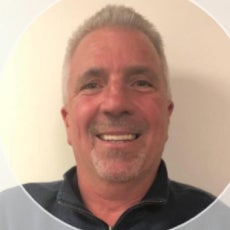
An avid golfer, Fran Mooney began his day like any other. Excited to play a round at his favorite golf course, he grabbed his clubs, hopped in the cart and headed out to play 18 holes. What he didn’t know, is that this was not going to be his best round. While traveling to the next par 3, Fran’s cart hit a curb and he fell out, landing on the back of his head. He was unconscious and rushed to the emergency room.
Fran sustained a traumatic brain injury or a TBI, and was in a coma for three weeks. Upon waking from the coma, he was agitated and confused which was different from Fran’s high energy and fun personality. Once doctors stabilized his medical status, they put a plan in place. He started rehabilitation immediately. He needed to re-learn how to walk, eat, and do basic everyday tasks. Fran was determined and pushed through rehab like he was Tiger Woods at the 2019 Masters tournament. But there was one thing Fran hadn’t mastered yet. To gain full independence, he needed to be able to drive and not have to depend on his family for transportation.
Fran was referred to Easterseals Driver Assessment program and worked closely with Raechaell Corbett MS OTR/L CDRS. Raechaell started this process with an clinical assessment on a driving simulator. It included checking his vision, cognition, and physical abilities as well as his reaction time- all skills needed to drive safely. Raechaell discovered that Fran required Occupational Therapy to address his visual scanning, visual attention, and overall cognitive processing speed to be able to participate in the behind the wheel assessment. He returned to Easterseals for Occupational Therapy to address the functional skills he needed to work on and then participate in a behind the wheel assessment. Unfortunately, this did not go as he had hoped. Fran was very distracted and it was determined that he was not yet ready to drive. While he was disappointed, that didn’t stop him. Fran was advised to continue to work on his attention and was given activities to complete at home on his own to work on this skill. After 3 months Fran was ready to try again. This time he passed! Fran was ready to drive safely and was the happiest he had been since before his accident. Upon completion of the program, Fran said, “Easterseals Driver Assessment program was the last piece that I needed to fit in my puzzle. I am grateful to Raechaell for her knowledge and patience with me during this process. She helped me get my life back”. Fran has returned to work, and is now able to drive on his own.
Congratulations Fran, the comeback is always greater than the setback!
Our blog
-
Advice for Freelance Writers From an Award-Winning Disabled Games Journalist
Thursday, October 31, 2024, 10:58 AMAdvice for Freelance Writers From an Award-Winning Disabled Games Journalist
Thursday, October 31, 2024, 10:58 AM
By Grant Stoner October marks National Disability Employment Awareness Month (NDEAM), a time to high…
Read this Post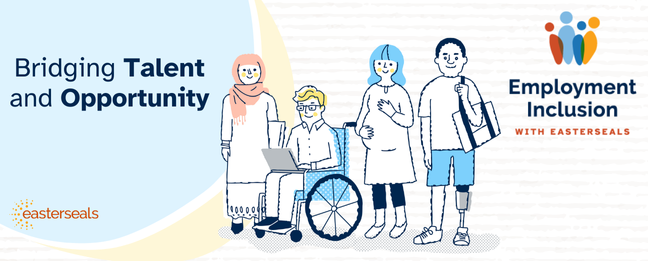 By Grant Stoner
By Grant StonerOctober marks National Disability Employment Awareness Month (NDEAM), a time to highlight the importance of equal opportunities within the workforce for disabled individuals. This year’s theme, “Access to Good Jobs for All,” reinforces the narrative that everybody is deserving of a well-paying job. And for disabled Americans still fighting for issues like marriage equality, financial security, and accessible spaces, it’s a step in the right direction for the government to acknowledge this aspect of the disabled experience.
For me, NDEAM allows me to reflect on my career as an accessibility reporter in the gaming industry. While I have yet to acquire a full-time job, my work as a freelancer has offered me numerous opportunities to earn money for things like savings, important life events, and even fun treats for friends and family. With my five years of experience, I wanted to share some tips for those interested in becoming a gaming journalist, more specifically, a disabled gaming journalist.
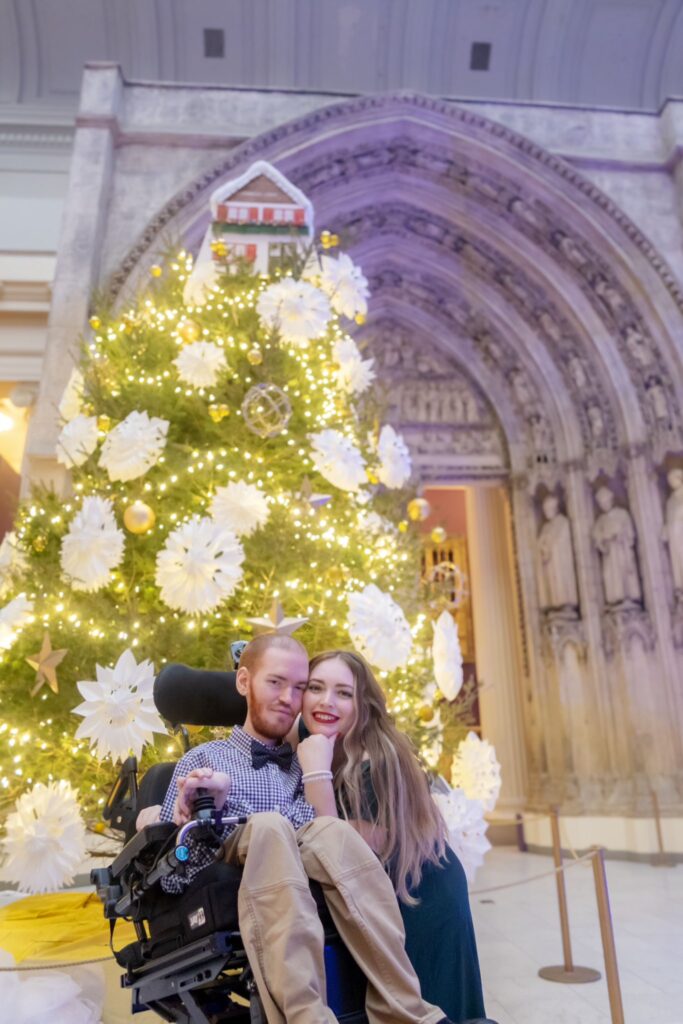
Grant and his girlfriend
Write, Write, and Write
This may seem obvious, but to be a journalist, you need to write. I’ve been professionally writing since 2019, publishing numerous reviews, developer interviews, community reports, and even opinion pieces on the state of accessibility in the gaming industry. But long before I had bylines at publications like IGN, WIRED, and Easterseals, I began learning how to convey my thoughts into cohesive sentences at my university’s school newspaper.
Since 2015, I’ve written with the goal of becoming a games journalist. While I initially had no intention of exploring accessibility and the disabled perspective with my stories, I always wanted to see my name on websites and within magazines that I grew up reading. And when I first started, I was admittedly terrible. My stories lacked emotion, instead, being nothing more than a checklist of a game’s features followed by a quick, ultimately meaningless sentence of whether I liked a title. I was never going to impress editors with my mediocrity. But with each review, each feature within the school newspaper, each draft returned by my editors, I became more confident in myself as a writer.
Despite graduating with a degree in Multiplatform Journalism, I will be the first to admit that I didn’t learn how to become a writer by attending college courses. Instead, my knowledge came directly from trial and error, as well as the guidance of my editors. And since higher education can be incredibly expensive and pose numerous barriers for disabled individuals, I’m here to tell you that you don’t need to have a degree to begin freelancing. You just need to prove to editors that you know how to write.
The Art of the Pitch
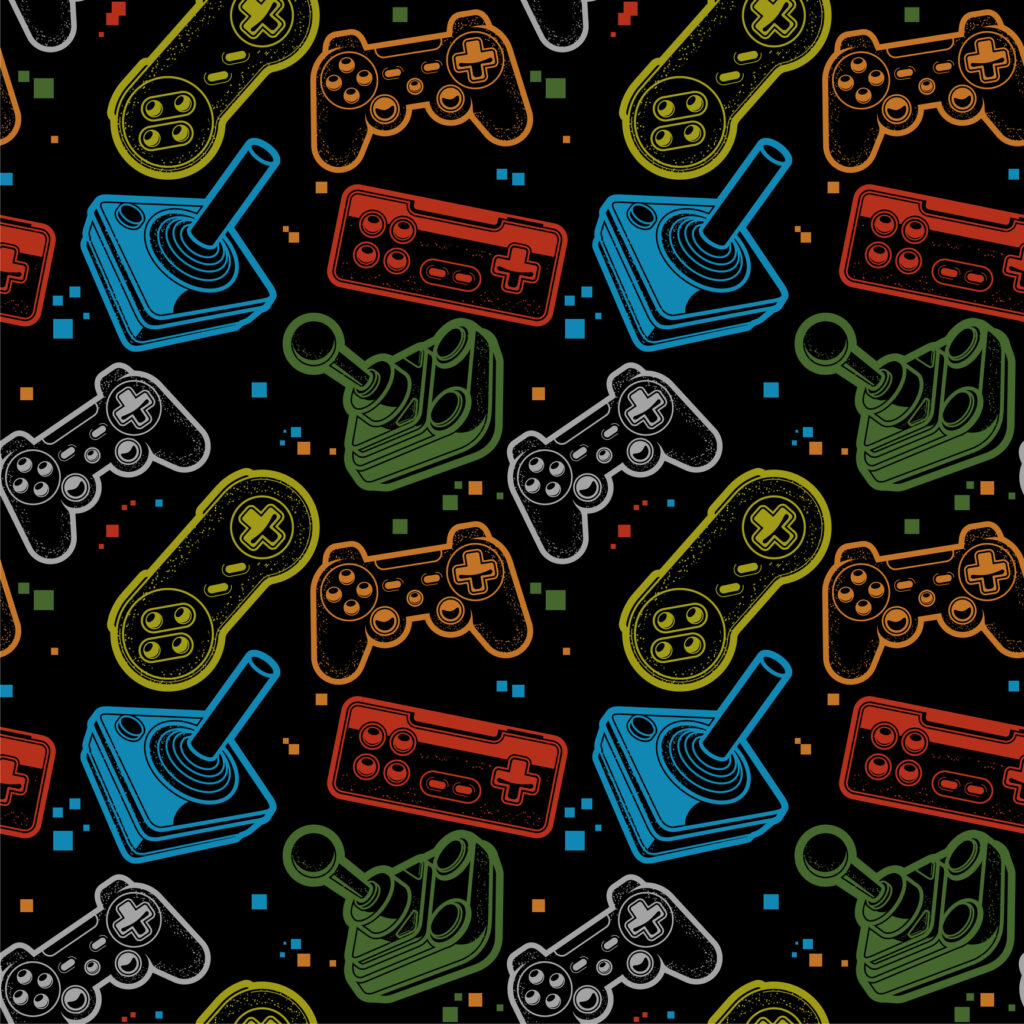
Before any good article comes to life, they all start as an idea. When writing independently, you don’t need the approval of others to begin developing your work. However, when freelancing, each article needs to capture the attention of whatever publication is worthy of your story. For example, with this very piece, I needed to convey to my editor – Hi, Erin! – that Easterseals’ readers would be interested in a feature exploring tips and tricks on how to freelance.
You need to provide samples for editors of your work. Show them why you are the best person to write the specific piece. If I’m pitching a story that deals directly with accessible innovations at studios like PlayStation, I’m going to demonstrate my knowledge on the subject through previous stories. And if you lack an extensive portfolio, utilizing your lived experience, particularly as a disabled individual, is just as important as having written examples.
Marginalized stories are best told by marginalized people. While it is possible for publications to write about disability and accessibility without hiring a disabled freelancer, you can prove to editors that your voice can provide nuance that others may lack. Did a company release a new piece of hardware, and do you have a physical disability? You can use this information to prove to editors that your years of using accessible devices makes you the right person for the job. Portfolios are important, but so is intrinsically understanding how to be disabled in the gaming industry.
Rejection Happens
When writing about subjects like accessibility and the disabled perspective, many publications often struggle to see the newsworthiness of these topics. Despite approximately 25% of the population living with some form of a disability, the nature of stories told about us continues to be framed as inspirational or pitiful. We still struggle to be viewed as confident and independent individuals, often infantilized for the enjoyment of others. And these preconceived notions and stereotypes of disabled people continue to plague the appeal of stories that actively push back against these beliefs. Unfortunately, this consistent uphill battle means publications may deny pitches.
My first freelance piece was published on October 5, 2018. Since then, I’ve published dozens of stories across numerous publications. Yet, for every story accepted, dozens have been rejected. And each reason can vary. From a lack of budgets to timeliness, and even an inability for editors to understand the importance of why certain stories need to be told means that I’m very familiar with rejection. While it’s important to acknowledge that rejection stings, it’s equally important to remember that one “no” does not make you a bad writer. As cliché as it sounds, the best piece of advice I can give is to keep pitching. Sometimes stories aren’t meant to be published, and sometimes it’s possible to save an idea for later, but a rejection is not a reflection of you as a writer.
I’m incredibly proud of the work I’ve done since I entered the professional space in 2019. And for this NDEAM, I’m incredibly thankful that I can continue doing this job I so dearly love. Yet, it’s important to remind others that disabled individuals belong in each space, not just the gaming industry. As we continue to normalize our voices across publications, we deserve a place within the workforce. As accessibility continues to evolve, disabled people need to be front and center to discuss these innovations.
Grant Stoner is a disabled journalist covering accessibility and the disabled perspective in the gaming industry. When not writing, he is usually screaming about Pokémon or his cat, Goomba, on social media.
-
A Look into Disability in Media and the RENEGADES Film Series
Thursday, October 24, 2024, 12:49 PM
By Day Al-Mohamed Welcome to National Disability Employment Awareness Month! So what is this “celeb…
Read this Post By Day Al-Mohamed
By Day Al-MohamedWelcome to National Disability Employment Awareness Month! So what is this “celebration” in October? In many ways, behind the anniversary of the Americans with Disabilities Act (ADA) on July 26th, October has grown to be the second largest disability-focused time period in the year (not including disability-specific days which may hold more significance for individual disabled communities). As per the US Department of Labor, NDEAM is the month where “we celebrate the value and talent workers with disabilities add to America’s workplaces and economy. NDEAM’s purpose is to confirm our commitment to ensuring disabled workers have access to good jobs, every month of every year.” It is a time where companies and businesses are encouraged to support, improve, and celebrate disability in their workplace. Why do we have this? Because disability is still not adequately represented in the workforce. Only 37.5% of the disabled population is employed as compared to 75% of the non-disabled population.
Despite Congress passing the ADA in 1990 and the rise of the disability rights movement, systemic discrimination is built into our processes and policies – in education, housing, healthcare, and most relevant for our conversation today, in employment. It is still legal to pay disabled employees subminimum wages in ‘sheltered workshops’ — a relic of the 1930s allowed by the Department of Labor under the auspices of maintaining employment opportunities for people with disabilities. Perhaps even more devastating in the current era of discussions around diversity, equity, and inclusion (DEI) in the workplace, disability is often forgotten.
The Centers for Disease Control state that 1 in 4 adults in America have a disability, yet nowhere is underrepresentation of the disability perspective more obvious today than in mass media. Film, television, and other media seem to have not embraced disability inclusion in a way that is meaningful. GLAAD’s 2020-2021 study analyzing the overall diversity of primetime scripted series on broadcast networks, “Where We Are On TV,” highlights the fact that only 3.5% of characters have a disability, many played by non-disabled actors, and that network television “severely underrepresents the U.S. population living with disabilities.” A recent USC Annenberg study of the 100 most popular movies of 2019 found that only 2.3% of all speaking characters were depicted with a disability, and nearly half of the films did not include a single character with a disability. While there are no analogous studies for behind-the-camera and those working on films, anecdotal evidence highlights similar disparities in representation.
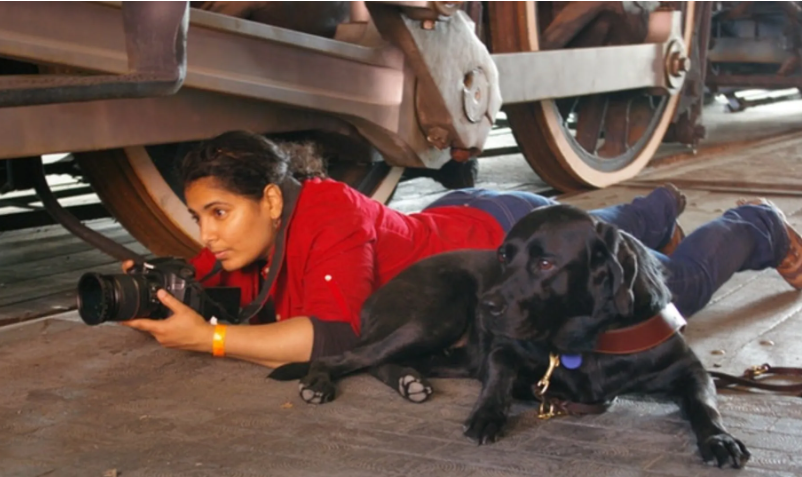
Day on the job.
That is part of the reason that disability was front and center in both the content of our American Masters/PBS series RENEGADES and also in process. RENEGADES is a series of five 10-minute short films designed for an intergenerational digital audience that showcases the lives of little-known historical figures with disabilities, exploring not only their impact on and contributions to U.S. society, but also the concept of disability culture, which honors the uniqueness of disability. Hosted and narrated by the musician and disability rights activist, Lachi, and created and produced by a team composed of more than 90% D/deaf and disabled filmmakers, the series is designed to increase public knowledge of disability, and also use these historical individuals’ lives as keystones to reexamine universal concepts such as identity, community, and normalcy from a disability culture perspective.
Infused with the spirit of the disability movement’s mantra, “Nothing About Us Without Us,” RENEGADES places a focus on authentic storytelling, with a cast and crew that are majority disabled people; and a majority filmmakers of color. Filmmaking is a “team sport” and like disability itself, it isn’t about independence so much as interdependence. Filmmakers with disabilities belong in media as much as any other industry. We believe our film series is proof of that.
In celebration of NDEAM, the RENEGADES short film series will be released on PBS’ website and YouTube channel starting October 1, with a new episode dropping every Tuesday. In addition, we are working with PBS Learning Media to develop curricula to bring a greater understanding of disability and history into classrooms across the country. The films are provided with ASL, Captions, and Audio Description, as well as an accessible transcript.
RENEGADES will feature the following groundbreaking individuals:
Judy-Lynn del Rey: Galaxy Gal – Premiered Tuesday, October 1
Judy-Lynn del Rey (1943-1986) was a woman with dwarfism who revolutionized the world of science fiction by editing and publishing books from sci-fi luminaries such as Arthur C. Clarke, Isaac Asimov, Philip K. Dick, and even George Lucas’ “Star Wars” in novel form. Through her story, RENEGADES shows how science fiction narratives, through their speculative and imaginative nature, offer a more inclusive and equitable lens through which to redefine disability.
Daniel Inouye: Life of Service – Premiered Tuesday, October 8
The first Japanese American to serve in the U.S. Congress, Daniel Inouye represented the State of Hawai’i for more than 50 years. As the first-born son of Japanese immigrants, Inouye’s early life was a balancing act of heritage and identity as an American. During his World War II service, he was injured in battle, resulting in the amputation of his right arm. Following the war and 22 months of rehabilitation, Inouye pivoted into law and public service, first winning territorial seats, then moving up to the U.S. House of Representatives, and then to the U.S. Senate. While also representing Hawaiian interests, his national policy work revolved around civil rights, civil liberties and support for policies that promoted equality for all peoples.
Celestine Tate Harrington: Building A Legacy – Premiered Tuesday, October 15 (Her birthday!)
Born with a condition that left her limbs unusable, Celestine Tate Harrington was a street performer in downtown Philadelphia and on the Atlantic City boardwalk in the 1980s and 1990s who impressed audiences with her skill at playing the electric keyboard with her tongue. When the Philadelphia Department of Public Welfare attempted to take away her infant daughter, claiming that Harrington was physically incapable of caring for a child, she successfully defended her right to parent. In the courtroom, Tate Harrington demonstrated her skills – dressing and undressing her daughter, and changing her diaper, using only her lips, teeth, and tongue – and retained custody. She used the limited preconceived notions of others to prove that she was capable of raising a family and breaking the cycle of poverty.
Thomas Wiggins: Composing the Future – Premiered Tuesday, October 22
A composer and pianist known as the greatest musical prodigy of his time, Thomas Wiggins was blind from birth. Some contemporary sources have also noted behaviors that indicate he also had autism. Born into slavery, Wiggins was the first African American to perform at the White House and toured throughout the U.S., South America and Europe. The Emancipation Proclamation went into effect in 1863, but Wiggins was put under a conservatorship, and fought over in the courts as property – perpetual bondage until his death.
Brad Lomax: Creating Communities of Care – Premieres Tuesday, October 29
A civil rights and disability rights leader who had multiple sclerosis and used a wheelchair, Brad Lomax was a member of the Black Panther Party and founder of the East Oakland Center for Independent Living. He was a key protester during the historic 26-day sit-in of 1977 at the Federal Building in San Francisco, which demanded the federal government enforce regulations to prohibit discrimination of people with disabilities.
You can read more about the series in the Press Announcement, or you can check it out in more detail at the PBS website.
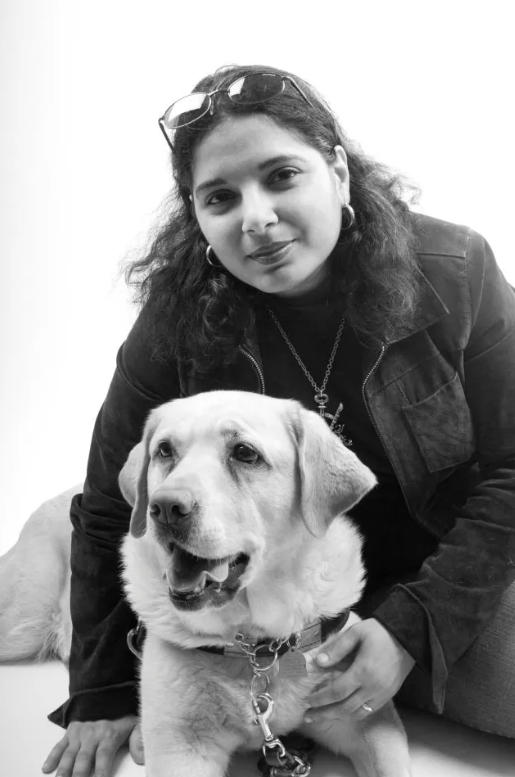 Day Al-Mohamed is an author, filmmaker, and disability policy advisor. Day has written two novels, “Baba Ali and the Clockwork Djinn” and more recently, “The Labyrinth’s Archivist” as well as multiple short stories and articles. She is a regular host on Idobi Radio’s Geek Girl Riot with a weekly audience of 100k+ listeners and a Founding Member of FWD-Doc (Documentary Filmmakers with Disabilities).
Day Al-Mohamed is an author, filmmaker, and disability policy advisor. Day has written two novels, “Baba Ali and the Clockwork Djinn” and more recently, “The Labyrinth’s Archivist” as well as multiple short stories and articles. She is a regular host on Idobi Radio’s Geek Girl Riot with a weekly audience of 100k+ listeners and a Founding Member of FWD-Doc (Documentary Filmmakers with Disabilities).Her documentary, THE INVALID CORPS, about disabled Civil War soldiers, was licensed to Alaska Airlines and had its broadcast premiere on public television in 2020. She is currently working on a docu-series, RENEGADES, of role-breaking disabled leaders in history for American Masters/PBS digital (October 2024) and is a proud producer of feature documentary UNSEEN (POV, 2024). Day was named a DOC NYC 2021 Documentary New Leader, was part of the NBC 2022 Original Voices Fellowship class, and awarded a Disability Futures Fellow grant in 2024.
Outside of her creative work, Day is a policy expert with over 15 years of experience. The former White House Director of Disability Policy, she is a proven leader in inclusion and accessibility, policy development, organizational transformation, and innovative program design. Day lives in Washington DC with her wife, N.R. Brown, daughter Octavia, and guide dog.
-
My Experiences Before and After Getting Hearing Aids
Friday, October 18, 2024, 11:29 AM
By Rikki Poynter In August 2021 at 30 years old, I got my first pair of hearing aids after being dia…
Read this PostBy Rikki Poynter
In August 2021 at 30 years old, I got my first pair of hearing aids after being diagnosed with hearing loss at 11. Why didn’t I get them when I was 11? I qualified for them, but they were too expensive. I don’t know the average cost of hearing aids back in 2002, but now in 2024, the average cost is $4,000 for a pair. With only one income in the household, a truck driver’s salary, there was no way we could afford them. And unfortunately, most insurance companies tend to not pay for them.
(This is also partially due to the fact that when it came to my accessibility needs, they were ignored. My parents, even my deaf mother, did not put in the effort to learn what I needed and give me the tools to know what I needed as well.)
I grew up with zero additional accommodations for my deafness. In school, I had to go through class without ASL interpreters and notetakers. I had to watch films and documentaries in school with captions. I had to participate in reading aloud in English class without any way of knowing for sure where we were on the page. My grades suffered and I graduated from high school with a 2.6 GPA.
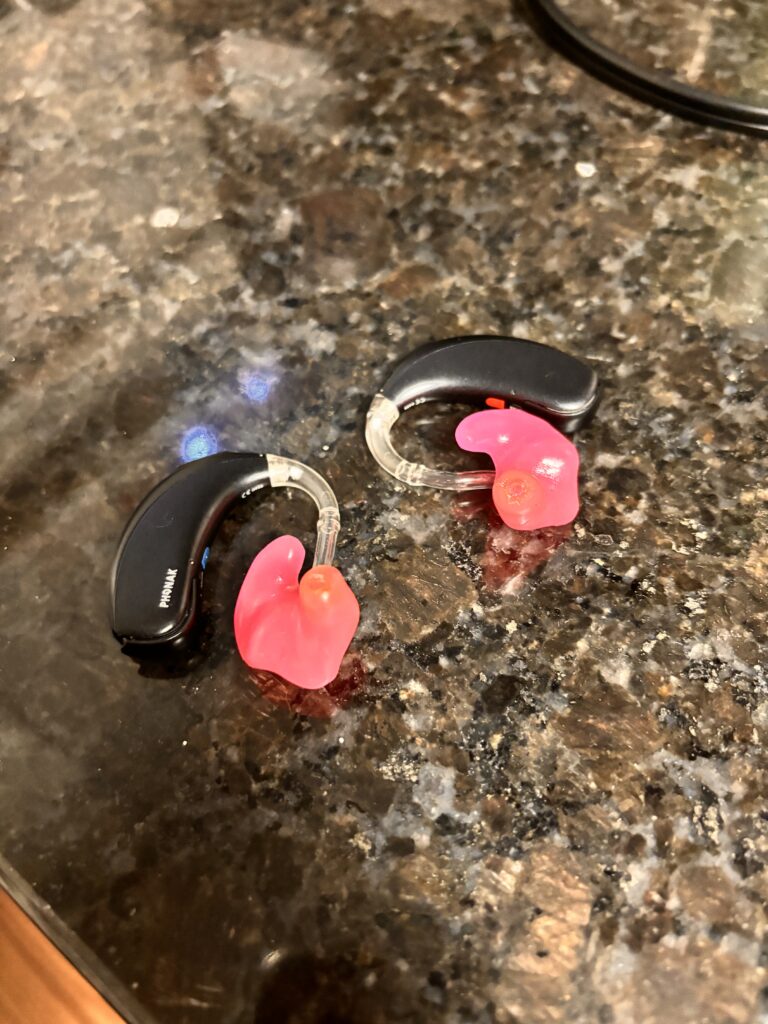 My social life took a hit. One-on-one socialization was okay, but being in a group setting was difficult. Being in two relationships with hearing men and going to family dinners where none of them signed (except for my first ex-boyfriend) meant experiencing Dinner Table Syndrome, where a deaf person is surrounded by hearing people who don’t know sign language and put little effort into equal communication which causes the deaf person to miss out on conversation.
My social life took a hit. One-on-one socialization was okay, but being in a group setting was difficult. Being in two relationships with hearing men and going to family dinners where none of them signed (except for my first ex-boyfriend) meant experiencing Dinner Table Syndrome, where a deaf person is surrounded by hearing people who don’t know sign language and put little effort into equal communication which causes the deaf person to miss out on conversation.As the years went by and my hearing loss became more progressive, it was becoming more difficult to do my work. I’ve been a content creator for over a decade and I speak in most of my videos. I edit my own videos, and for a few years, I had a company who would sponsor my captions. Unfortunately, that eventually ended, and I had to do the captions myself. Editing, and especially captioning, was becoming too difficult as no headphones were good enough for me to be able to understand myself. My speaking engagements on my own or at conferences were fine with the help of an ASL interpreter and captions, but once they were off the clock and it was time for the social events, I was left on my own. Attempting to lip read people while extremely loud music is playing on top of a few alcoholic drinks especially was practically impossible.
Then around April 2021, I learned about Vocational Rehabilitation Services (VR), an organization that aids disabled people in preparing for and finding a job. My friends have told me that they’ve received various things from them for their schooling and businesses like iPads, video phones, laptops, and, of course, hearing aids. So I sent in an email and crossed my fingers.
After a few months of going over my business, finances, a new audiogram, and waiting to be approved, I was fitted for and then received my hearing aids the following August, all for free.
Getting them activated was definitely an experience. I went from barely being able to hear anything at all to suddenly being bombarded with loud voices in a matter of seconds. Hearing people are used to seeing edited videos of babies and adults smiling and crying upon hearing aid and cochlear implant activation. My experience, however, was pretty neutral. “Oh, wow. That’s loud.” I didn’t cry tears of joy like the people in the videos.
(For the record, I’ve nothing against the people in the videos and their emotions are valid. I, as many others, question hearing people’s reaction to them when they’ve only seen one experience. An experience that is edited and doesn’t show the whole picture.)
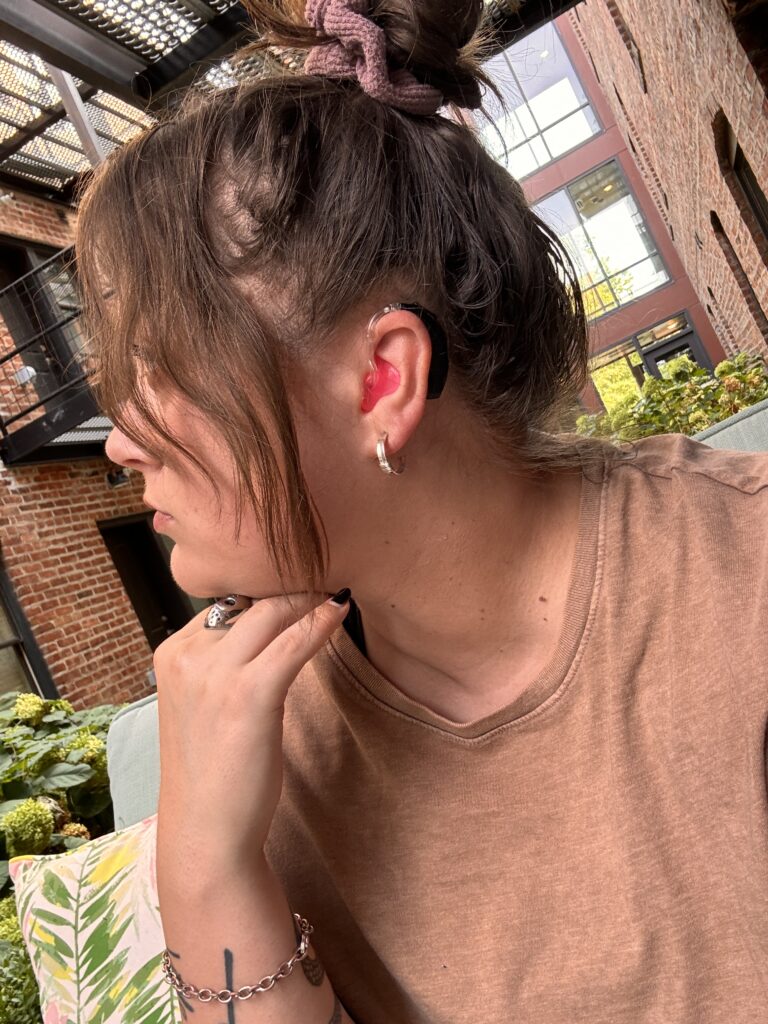 My hearing aids are the Phonak Naida P50 with black hardware and pink earmolds. (I’m slightly kicking myself for not getting black earmolds now.) They have Bluetooth, something I absolutely needed for work. I could stream my entertainment and my work content directly into my ears and I understood so much more than when I was using headphones and AirPods. When I finally figured out that I could connect them to my iMac, it changed the editing game for me. And even better, I got to take extra joy in my third rewatch of One Tree Hill.
My hearing aids are the Phonak Naida P50 with black hardware and pink earmolds. (I’m slightly kicking myself for not getting black earmolds now.) They have Bluetooth, something I absolutely needed for work. I could stream my entertainment and my work content directly into my ears and I understood so much more than when I was using headphones and AirPods. When I finally figured out that I could connect them to my iMac, it changed the editing game for me. And even better, I got to take extra joy in my third rewatch of One Tree Hill.My social life became easier, especially having moved to Omaha last year. The downside is that it does feel like I have to hold the burden of making communication easier for the person I’m talking to rather than the other person trying to make it an equal effort, which is how it was before getting the hearing aids.
Editing and captioning my work is so much easier. It’s not perfect and I still struggle to understand myself sometimes especially if I’m not talking directly to the camera, but it is a drastic improvement compared to five years ago. I can get around better at networking during events. It’s still difficult to understand everything if I’m at a panel or workshop, so I still request ASL interpreters for that.
While there has been a drastic change for the better, that doesn’t mean they’re perfect. I still can’t make regular phone calls. I still have to use an IP relay (think TTY, the typing telephone, but online). I still have to use captions while watching online content. I still need captions when going to the movie theater and watching TV.
Getting over my nerves and taking a chance with VR is by far one of the best decisions I’ve made in my life. I know my life wouldn’t be the way it is now had I not gotten them, which is an unfortunate thing to say, but it’s true.
But what I want people reading this to know is that hearing aids and cochlear implants are a big personal decision. Some of us want them, some of us don’t. Some of us qualify for them, some of us don’t. Sometimes they work for us, and sometimes they don’t work at all. Everyone is different and just because my experience has been a good one, doesn’t mean it’ll be the same for the next deaf person one comes across.
Rikki Poynter is a disabled (deaf, chronic pain and fatigue) accessibility consultant, writer, public speaker, and content creator. Originally a beauty vlogger on YouTube, she moved onto talking about her journey growing up as a mainstreamed deaf person trying to find her deaf identity and community all while trying to navigate an inaccessible world. Since 2013, she has talked about making the Internet accessible to deaf and hard of hearing people with captions, transcripts, and more. Her work has gotten the attention of many news outlets and she has worked with Apple, FireFox, Samsung, Google, and more.
-
Workforces Beyond Compliance: Building a Truly Accessible Workplace for All
Thursday, October 10, 2024, 12:11 PMWorkforces Beyond Compliance: Building a Truly Accessible Workplace for All
Thursday, October 10, 2024, 12:11 PM
By Andrea Jennings National Disability Employment Awareness Month, known as NDEAM, is honored and ob…
Read this Post
By Andrea Jennings
National Disability Employment Awareness Month, known as NDEAM, is honored and observed annually each October. This year, in 2024, the NDEAM Theme is “Access to Good Jobs for All.” Assistant Secretary of Labor for Disability Employment Policy, Taryn Williams, announces this year’s official theme in this video. When I read the title of this theme, what resonates with me is that society is finally moving past disabled individuals just “securing” a job. This empowering theme indicates that we seek viable, sustainable employment beyond compliance and merely compliant-based accessibility. This theme pushes for accessible jobs and careers at the forefront that have liveable wages and are psychologically and culturally safe environments for all.
Often, when attempting disability inclusion, many companies focus only on compliance with the Americans with Disabilities Act (ADA) and meeting specific diversity quotas. However, by solely doing it this way, disability inclusion is not being set up for success. While these efforts are essential, they often stop short of fostering authentic accessibility and inclusivity. Compliance alone, though crucial, can become more of a box-ticking exercise and performative if anything else. If companies limit their focus to meeting legal requirements and quotas, they miss out on creating a genuinely accessible workplace that benefits and empowers all employees, including those with disabilities. So, it is not the accessibility and equity programs at fault; it is how they are being implemented and, more importantly, why they are being implemented in the first place.
“Creating and developing programs that reflect multicultural communities is the way of the future. Disabled individuals and other underrecognized groups are overlooked and underserved and could benefit from universally designed infrastructures. Many are opinion leaders in their communities and can contribute to the workplace in many ways, given an equitable opportunity.” -Andrea Jennings
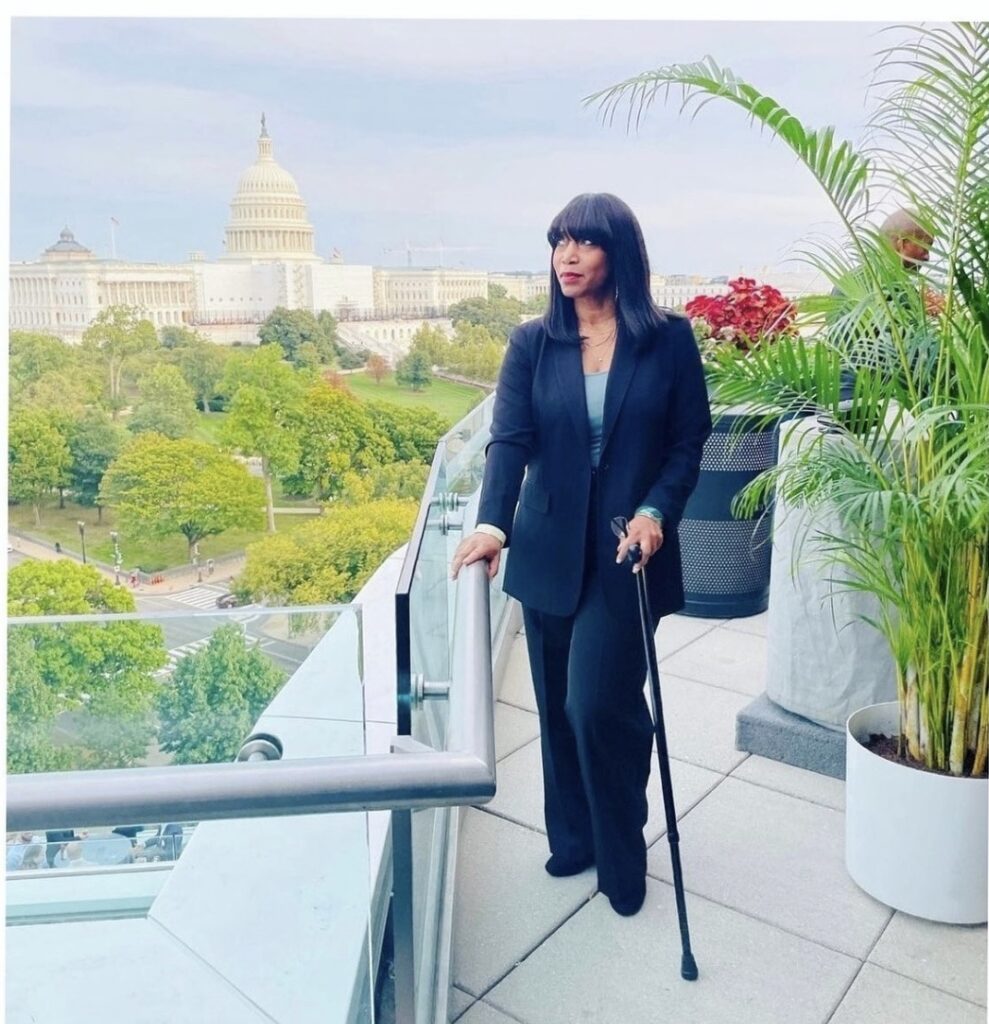
Compliance is the starting point. I can tell when a company is serious about wanting to drive real accessibility culture change in their organization because of their discovery questions when I first meet with them about securing my services to help them. One of the giveaways is that they genuinely want to learn themselves. They have done some basic research, just as one would if they were taking an out-of-country excursion. They wanted to know about a new culture carefully and enthusiastically because they did not want to offend that culture. The company’s representative usually wants to involve me in deeper layers of their company culture past a lunch webinar, and they want to truly learn how to integrate accessibility throughout their companies. They also have a budget because they value my expertise, lived experience, and Disability culture. Organizations seeking authentic change seek out disabled individuals like myself or work with larger companies like Easterseals, who work with authentic disabled individuals who understand that accessibility is not a one-and-done lab “program” or a one-person department, they know that it is an ongoing lifestyle and a community. Organizations that view accessibility as the bare minimum do little to address the attitudinal and systemic barriers that disabled employees face daily. Disability inclusion must go beyond quotas and metrics to focus on meaningful inclusion—ensuring that people with disabilities are not just present in the workforce but are also genuinely valued as contributors.
Breaking Down Attitudinal Barriers
One of the most significant challenges to workplace inclusivity is the persistence of attitudinal barriers. The JAN Accommodation Toolkit is an excellent resource for employers to learn to go above and beyond compliance. Many employers and coworkers make assumptions about the abilities of people with disabilities, often underestimating their potential. These biases are harmful to accessibility by creating an environment where disabled employees are viewed through a lens of pity or infantilization rather than as respected professionals with valuable skills.
For companies to progress, they need to foster an environment of open dialogue and respect. The key is to shift the paradigm from focusing on an individual’s disability to understanding and eliminating the barriers that prevent their full participation. For me, it was never my disability that prevented my inclusion. It was the barriers.
Tokenism: A Barrier to Authentic Inclusion
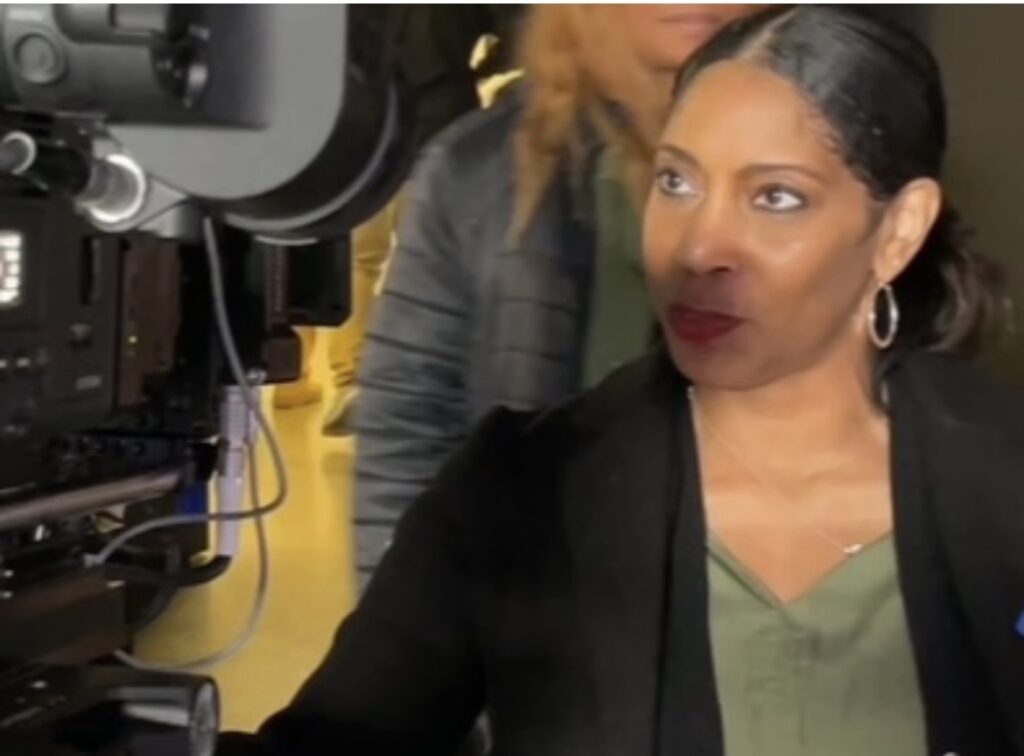 Tokenism is the practice of recruiting individuals with disabilities without even considering that there are qualified disabled candidates just to meet a quota. Tokenism limits opportunities for growth, real collaboration, and contribution. It is counterproductive to reduce employees to mere statistics. I am not a statistic but a human with lived experience. Tokenism not only hurts the experiences of disabled workers but also undermines the overall inclusivity of the organization.
Tokenism is the practice of recruiting individuals with disabilities without even considering that there are qualified disabled candidates just to meet a quota. Tokenism limits opportunities for growth, real collaboration, and contribution. It is counterproductive to reduce employees to mere statistics. I am not a statistic but a human with lived experience. Tokenism not only hurts the experiences of disabled workers but also undermines the overall inclusivity of the organization.Genuine inclusion requires integrating qualified people with disabilities into all aspects of the workplace, from leadership roles to daily operations. It also recognizes that because of systemic ableism, there are opportunities and experiences that disabled individuals have not been invited to experience. Organizations must invest in bridging that gap by offering development programs for disabled employees who want that support and providing them with the tools, mentorship, and opportunities they should have always had to set them up for success.
Recognizing the Value of Disabled Employees
Recognition and ensuring people feel seen and heard figuratively speaking is powerful. The benefits of going beyond tokenism are immense. Employees with disabilities are opinion leaders who bring many unique perspectives and skills to the table, which can enhance overall team performance. Studies have shown that diverse teams, including those with disabled members, are more innovative and adaptable.
By recognizing employees with disabilities as valuable contributors, companies can build a stronger, more dynamic workforce.
Authentic Inclusion: A Path to Innovation and Psychological Safety
Genuine accessibility and inclusion environments benefit all employees and lead to a more innovative and productive workplace. Companies that foster authentic inclusion create psychologically safe environments where all employees feel empowered to voice their ideas and concerns. How many times have you worked better because you felt comfortable? I am sure it has affected you in some way. Think about this: Are you talking to your employees about this subject to increase collaboration, innovation, and a better work environment that values diversity as an asset? Or are you talking about accessibility as an obligation? If it is the latter, it is time for a change. Please consider utilizing some of these ideas from the 31 Days of NDEAM published by the Department of Labor.
Accessible and inclusive workspaces are the future! They are places of growth, creativity, and psychological safety where everyone can be successful. These spaces level the playing field for success. Companies that embrace this mindset are aligned for better company morale and better positioned for long-term success.
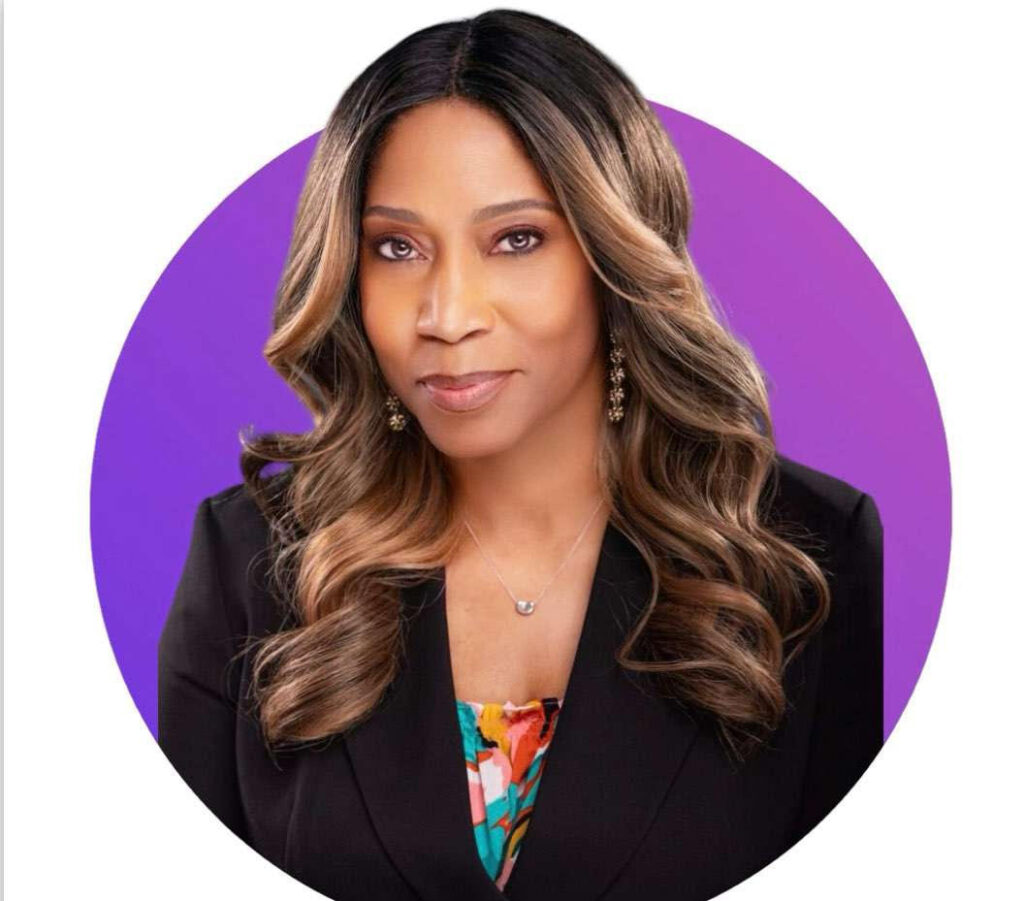 Andrea Jennings, M.Mus., Series TV host and a producer for Access for All: Integrating Accessibility, is a disability & accessibility in media Strategist, director, and lead actress in an award-winning film. Passionate about music, law, and entertainment. Her journey led to creating Shifting Creative Paradigms – Leveling The Playing Field®, a multi-media social enterprise production co. that advocates for social justice through Disability culture, film, music, and art. She is a chair emeritus and current commissioner for an Accessibility and Disability Commission. Andrea’s scholarly contributions include co-authoring the pivotal health equity report, The Atlantic | OPRG’s report on “The Intersection of Health Equity in Communities & Business Strategy,” which addresses systemic challenges in health equity. Her work has graced prestigious platforms like Park Avenue Armory, The Metropolitan Museum of Art, and Rutgers University. Her work has also been recognized in Forbes, Billboard Magazine, The Atlantic Magazine, The Hollywood Reporter, and The New York Times.
Andrea Jennings, M.Mus., Series TV host and a producer for Access for All: Integrating Accessibility, is a disability & accessibility in media Strategist, director, and lead actress in an award-winning film. Passionate about music, law, and entertainment. Her journey led to creating Shifting Creative Paradigms – Leveling The Playing Field®, a multi-media social enterprise production co. that advocates for social justice through Disability culture, film, music, and art. She is a chair emeritus and current commissioner for an Accessibility and Disability Commission. Andrea’s scholarly contributions include co-authoring the pivotal health equity report, The Atlantic | OPRG’s report on “The Intersection of Health Equity in Communities & Business Strategy,” which addresses systemic challenges in health equity. Her work has graced prestigious platforms like Park Avenue Armory, The Metropolitan Museum of Art, and Rutgers University. Her work has also been recognized in Forbes, Billboard Magazine, The Atlantic Magazine, The Hollywood Reporter, and The New York Times. -
The Realities of Employment Discrimination for Disabled People
Tuesday, October 1, 2024, 3:43 PM
By Leah Smith In 1988, October was established by Congress as Disability Employment Awareness Month.…
Read this Post By Leah Smith
By Leah SmithIn 1988, October was established by Congress as Disability Employment Awareness Month. The goal of this designated month is to “raise awareness about disability employment issues and to celebrate the contributions of workers with disabilities.” Inarguably, one of the biggest employment issues facing the disability community today is employment discrimination.
According to the Equal Employment Opportunity Commission, “employment discrimination is to treat someone differently, or less favorably, for some reason.” This unfair treatment can be because of your race, color, religion, sex (including pregnancy, gender identity, and sexual orientation), national origin, disability, age (age 40 or older), or genetic information.
Of course, there are hundreds of different types of disabilities and ways in which they might impact employment opportunities. Disabilities can be cognitive, physical, and/or emotional, and often limit one or more major life activities.
It is also important to note the definition of ‘major life activities.’ A major life activity is something you do every day, including your body’s own internal processes. Some examples include:
- Actions like eating, sleeping, speaking, and breathing
- Movements like walking, standing, lifting, and bending
- Cognitive functions like thinking and concentrating
- Sensory functions like seeing and hearing
- Tasks like working, reading, learning, and communicating
- The operation of major bodily functions like circulation, reproduction, and individual organs
As of July 2024, the employment rate for people with disabilities was 37%, compared to 75% among their nondisabled counterparts. After looking at cases of disability employment discrimination, we can see that it usually falls within one of the 6 following categories:
- Hiring Discrimination: When qualified applicants are not hired based on their disability, rather than their skills or qualifications.
- Wage Discrimination: When employees are paid less than their colleagues for performing the same job because of their disability.
- Promotion Discrimination: When an employee is overlooked for promotions or advancements due to their disability.
- Harassment: A work environment where an employee is subjected to unwanted comments, jokes, or behaviors based on their disability creating a hostile or intimidating work atmosphere.
- Failure to Accommodate: When an employer fails to provide reasonable accommodations to employees with disabilities.
- Termination or Demotion: When employees are unfairly fired, demoted, or forced to quit due to their disability.
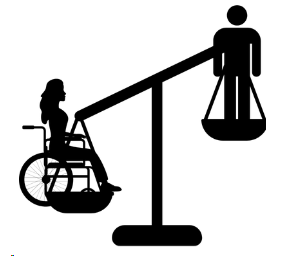 Of course, any one of these forms of discrimination can also happen at the intersection of other marginalized identities, only further impacting the individual and the organization. Being the recipient of employment discrimination can have long-term emotional, financial, and psychological impacts on someone’s life; however, it can also cause reduced productivity, cause higher turnover rates, have legal and financial repercussions, and cause a lack of diversity and inclusion within an organization. The term ‘intersectionality’ was coined by professor Kimberlé Crenshaw to describe how race, class, gender, and other individual characteristics “intersect” and overlap with one another. As this term has evolved, she has further explained, “Intersectionality is a lens through which you can see where power comes and collides, where it interlocks and intersects. It’s not simply that there’s a race problem here, a gender problem here, and a class or LBGTQ problem there. Many times, that framework erases what happens to people who are subject to all of these things.”
Of course, any one of these forms of discrimination can also happen at the intersection of other marginalized identities, only further impacting the individual and the organization. Being the recipient of employment discrimination can have long-term emotional, financial, and psychological impacts on someone’s life; however, it can also cause reduced productivity, cause higher turnover rates, have legal and financial repercussions, and cause a lack of diversity and inclusion within an organization. The term ‘intersectionality’ was coined by professor Kimberlé Crenshaw to describe how race, class, gender, and other individual characteristics “intersect” and overlap with one another. As this term has evolved, she has further explained, “Intersectionality is a lens through which you can see where power comes and collides, where it interlocks and intersects. It’s not simply that there’s a race problem here, a gender problem here, and a class or LBGTQ problem there. Many times, that framework erases what happens to people who are subject to all of these things.” Employment discrimination, particularly when viewed through an intersectional lens, underscores the severity of this issue.
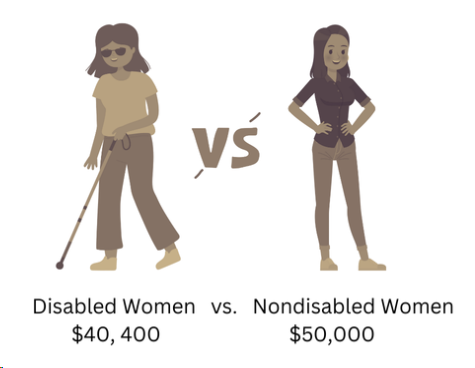 For example, we see a 20% wage gap between median annual earnings among nondisabled and disabled women in the United States.1 This breaks down to be about a $10,000 wage gap between nondisabled and disabled women ($40,400 compared to $50,000). (US Census Bureau, 2020)
For example, we see a 20% wage gap between median annual earnings among nondisabled and disabled women in the United States.1 This breaks down to be about a $10,000 wage gap between nondisabled and disabled women ($40,400 compared to $50,000). (US Census Bureau, 2020)This also means that, overall, disabled women are only paid .50 for every dollar a nondisabled man makes. (US Census Bureau, 2020)
Further, the wage gap between white disabled women and black disabled women highlights the intersection of race, gender, and disability in the labor market. On average, there is a 10-25% wage gap between black women with disabilities and white women with disabilities. Factors such as education, location, and type of disability can impact this figure.
According to another study, disabled transgender individuals are 5 times more likely than nondisabled cisgender individuals to report being unemployed and looking for work for more than a month. These data only further highlight Crenshaw’s point about how intersectionality shows ‘where power comes and collides.’
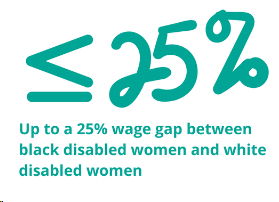 As a disabled woman, I find the above statistics to be sobering. But I couldn’t help but want real stories of real people I knew. So, like any good millennial, I took it to social media. As a disabled woman, employee, and mom, I asked over 1,400 friends, “what has employment discrimination looked like for you?” I received over 77 responses like:
As a disabled woman, I find the above statistics to be sobering. But I couldn’t help but want real stories of real people I knew. So, like any good millennial, I took it to social media. As a disabled woman, employee, and mom, I asked over 1,400 friends, “what has employment discrimination looked like for you?” I received over 77 responses like: - “Being told that they should have hired a nondisabled person instead.”
- “Prior to the pandemic, jumping through a ton of hoops and needing to disclose private medical information to have partial work-from-home status, but it took a pandemic that killed millions for work-at-home to be approved/acceptable.”
- “Given a hard ‘no’ because they were afraid I would get hurt due to heavy lifting and/or moving products around. Then given a teddy bear to make up for it.”
- “Told I was really lucky to have a job, as any other place would fire me for all of the accommodations I needed.”
- “After I finished undergrad, the job search process was hell! I would go in for interviews and would get stares. I would be qualified for positions and literally get ghosted from employers.”
- “I asked for an office chair that fits my body, and the response was ‘maybe you can just do something about your desk or how you’re sitting instead?’”
- “Being given the nickname ‘Eeyore’ by a boss because of my mental health disabilities.”
- “Was fired outright when they found out my label/disability.”
- “Supervisor telling HR I was refusing to do my job because I couldn’t do it without the reasonable accommodation they were denying.”
- “Being told that spending money to train me was a waste of resources, I’d never be management material. Then when I was a manager, moving my office to the former storage room because ‘watching you type is painful.’ I’ve been told that people like me don’t need to work because we can just live off federal disability, so I shouldn’t take a job away from someone with a family.”
- “Attending interviews where members of the interviewing panel asked how I dress myself and about my spouse.”
While many of us are aware that laws such as the Americans with Disabilities Act and Section 504 of the Rehabilitation Act are key pieces of legislation that provide some legal protections against disability discrimination, I would argue that, clearly, we haven’t done enough yet. Organizations like The National Center for Disability, Equity, and Intersectionality and American Progress, among many others, are advocating for key legislation that would end subminimum wage, get rid of asset limits for public assistance programs, increase funding for home and community based services, and pass the Equality Act as methods of helping to solve this problem. As Michelle Obama recently said, we just need to ‘Do Something!’
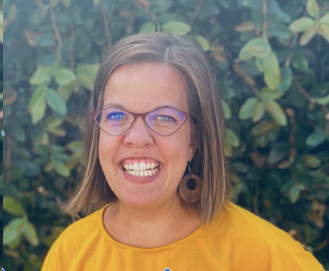 Leah Smith is the Associate Director of The National Center for Disability, Equity, and Intersectionality and Co-Facilitator for Her Power!, a national event aimed at teen girls with disabilities. She wears many hats, but being a mom to her two kids is, by far, the most important.
Leah Smith is the Associate Director of The National Center for Disability, Equity, and Intersectionality and Co-Facilitator for Her Power!, a national event aimed at teen girls with disabilities. She wears many hats, but being a mom to her two kids is, by far, the most important.
Let's Keep in Touch
Don't miss out on exciting news, helpful resources, and impactful stories delivered to your inbox each month.
Join Today